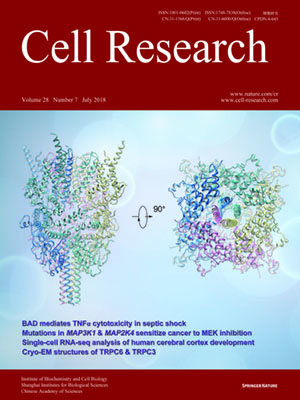
Volume 28, No 7, Jul 2018
ISSN: 1001-0602
EISSN: 1748-7838 2018
impact factor 17.848*
(Clarivate Analytics, 2019)
Volume 28 Issue 7, July 2018: 779-781
LETTERS TO THE EDITOR
PROTAC-induced BTK degradation as a novel therapy for mutated BTK C481S induced ibrutinib-resistant B-cell malignancies
Yonghui Sun 1, Xingwang Zhao 2, Ning Ding 3, Hongying Gao 1,2,Yue Wu 1, Yiqing Yang 1, Meng Zhao 2, Jinseok Hwang 2,Yuqin Song 3, Wanli Liu 2 and Yu Rao 1
1 MOE Key Laboratory of Protein Sciences, School of Pharmaceutical Sciences, MOE Key Laboratory of Bioorganic Phosphorus Chemistry and Chemical Biology, Tsinghua University, Beijing 100084, China;2MOE Key Laboratory of Protein Sciences, Collaborative Innovation Center for Diagnosis and Treatment of Infectious Diseases, School of Life Sciences, Beijing Key Lab for Immunological Research on Chronic Diseases, Tsinghua University, Beijing 100084, China and 3 Key laboratory of Carcinogenesis and Translational Research (Ministry of
Education), Department of Lymphoma, Peking University Cancer
Hospital and Institute, No.52 Fucheng Road, Haidian District, Beijing
100142, China
Correspondence: These authors contributed equally: Yonghui Sun, Xingwang Zhao,Ning Ding, Hongying Gao.Correspondence: Wanli Liu (liuwanli@biomed.tsinghua.edu.cn) orYu Rao (yrao@tsinghua.edu.cn)
Dear Editor,
Non-Hodgkin’s lymphoma (NHL) is a type of cancer that mainly develops from B-cell malignancies, causing 231,400 deaths in 2015 globally. According to the American Cancer Society, around 66,000 new cases of NHL are diagnosed each year in the United States.1 Bruton’s tyrosine kinase (BTK) is an enzyme encoded by the BTK gene in human. BTK is expressed in all cell lineages of the hematopoietic system except for T cells.2 As a cytoplasmic tyrosine kinase of the TEC family, BTK plays a crucial role in B cell development, differentiation, and signaling. BTK is closely associated with chronic B-cell receptor (BCR) activation, and is critical for the survival of B-cell neoplasms.3
https://doi.org/10.1038/s41422-018-0055-1
FULL TEXT | PDF
Browse 1953


